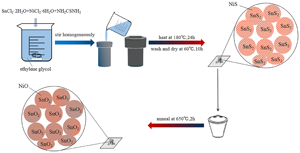Crossref Citations
This article has been cited by the following publications. This list is generated based on data provided by
Crossref.
Tian, Chunxia
Li, Haiying
Tian, Xi-Ang
and
Liu, Li
2021.
Promotion on Formaldehyde Sensing of 3D Porous SnO2 by Eu Doping.
IEEE Sensors Journal,
Vol. 21,
Issue. 19,
p.
22032.
Maheswari, S.
Karunakaran, M.
Hariprasad, K.
Kasirajan, K.
Chandrasekar, L. Bruno
Alshahrani, T.
Shkir, Mohd.
and
AIFaify, S.
2021.
Enhanced room-temperature ammonia vapor-sensing activity of nebulizer spray pyrolysis fabricated SnO2 thin films: an effect of Er doping.
Journal of Materials Research,
Vol. 36,
Issue. 3,
p.
657.
Shihabudeen, P. K.
and
Roy Chaudhuri, Ayan
2021.
Ethanol sensing properties of nitrogen doped In2O3 thin films.
Journal of Materials Research,
Vol. 36,
Issue. 7,
p.
1561.
Hu, Qingmin
Ma, Zhiheng
Yang, Jie
Gao, Tiange
Wu, Yue
Dong, Zhe
Li, Xuyi
Zeng, Wen
Zhao, Shichao
and
Xu, Jiaqiang
2021.
Ultrathin PANI-Decorated, Highly Purified and Well Dispersed Array Cncs for Highly Sensitive HCHO Sensors.
Chemosensors,
Vol. 9,
Issue. 10,
p.
276.
Zhu, Yujun
Zhang, Fan
Wang, Kaifang
Zhang, Yawen
Gu, Xiuzhi
fa Yuan, Zheng
and
Liu, Xin
2021.
A Formaldehyde Indoor Gas Sensor Based on Hierarchical α-Molybdenum Trioxide.
Journal of Nanoelectronics and Optoelectronics,
Vol. 16,
Issue. 6,
p.
987.
Kalangestani, F. Chharganeh
Simiari, M.
and
Ghodsi, F. E.
2022.
Fabrication of V2O5/NiO double-layer film with hydrophilic property and evaluation of the effects of V2O5 coating on electro-optical parameters of NiO film.
Applied Physics A,
Vol. 128,
Issue. 5,
Lou, Chengming
Lei, Guanglu
Liu, Xianghong
Xie, Jiayue
Li, Zishuo
Zheng, Wei
Goel, Neeraj
Kumar, Mahesh
and
Zhang, Jun
2022.
Design and optimization strategies of metal oxide semiconductor nanostructures for advanced formaldehyde sensors.
Coordination Chemistry Reviews,
Vol. 452,
Issue. ,
p.
214280.
Shihabudeen, P. K.
and
Roy Chaudhuri, Ayan
2022.
Nitrogen doped In2O3–ZnO nanocomposite mesoporous thin film based highly sensitive and selective ethanol sensors.
Nanoscale,
Vol. 14,
Issue. 13,
p.
5185.
Kong, Yulin
Li, Yuxiu
Cui, Xiuxiu
Su, Linfeng
Ma, Dian
Lai, Tingrun
Yao, Lijia
Xiao, Xuechun
and
Wang, Yude
2022.
SnO2 nanostructured materials used as gas sensors for the detection of hazardous and flammable gases: A review.
Nano Materials Science,
Vol. 4,
Issue. 4,
p.
339.
John, Riya Alice B.
Shruthi, Julakanti
Ramana Reddy, M.V.
and
Ruban Kumar, A.
2022.
Manganese doped nickel oxide as room temperature gas sensor for formaldehyde detection.
Ceramics International,
Vol. 48,
Issue. 12,
p.
17654.
Li, Xiang-Bing
Luo, Zhi-Hua
Zhang, Yan
Dong, Xu-Jie
Zhang, Chun-Juan
Dang, Wen-Qiang
Zhang, Li-Jun
Zhao, Yu-Xiang
Liu, Xiao-Bin
Wang, Yu-Ping
Zhao, Li-Min
An, Jian-Zhen
Kang, Xue-Fu
Zhao, Wen-Bo
and
Liu, Qing
2022.
Excellent sensitivity of SnO2 nanoparticles to formaldehyde.
Modern Physics Letters B,
Vol. 36,
Issue. 32n33,
Das, Tanushri
Mojumder, Subhajit
Chakraborty, Sonam
Saha, Debdulal
and
Pal, Mrinal
2022.
Beneficial effect of Sn doping on bismuth ferrite nanoparticle-based sensor for enhanced and highly selective detection of trace formaldehyde.
Applied Surface Science,
Vol. 602,
Issue. ,
p.
154340.
Tian, Chunxia
Tian, Xi-ang
Li, Yu
Wang, Zhijun
and
Liu, Li
2022.
Improve the Formaldehyde Gas-Sensing Performance of 3D Porous SnO2 by Controlling the Calcination Time and the Amount of Holmium Doped.
Journal of Electronic Materials,
Vol. 51,
Issue. 1,
p.
214.
Cova, Camilla Maria
Rincón, Esther
Espinosa, Eduardo
Serrano, Luis
and
Zuliani, Alessio
2022.
Paving the Way for a Green Transition in the Design of Sensors and Biosensors for the Detection of Volatile Organic Compounds (VOCs).
Biosensors,
Vol. 12,
Issue. 2,
p.
51.
Dan Meng
Qiao, Tongtong
Wang, Guosheng
Shen, Yanbai
San, Xiaoguang
Li, Ruixiang
and
Meng, Fanli
2022.
Rational design of CuO/In2O3 heterostructures with flower-like structures for low temperature detection of formaldehyde.
Journal of Alloys and Compounds,
Vol. 896,
Issue. ,
p.
162959.
Meng, Dan
Kang, Jiaqi
Wang, Mingyue
Wang, Nana
San, Xiaoguang
Zhang, Yue
Qi, Jian
and
Jin, Quan
2023.
Construction of hexagonal hollow rod-shaped NiCo2O4–In2O3 p-n heterojunction for low concentration formaldehyde detection.
Vacuum,
Vol. 217,
Issue. ,
p.
112578.
Meng, Dan
Xie, Zongsheng
Wang, Mingyue
Xu, Juhua
San, Xiaoguang
Qi, Jian
Zhang, Yue
Wang, Guosheng
and
Jin, Quan
2023.
In Situ Fabrication of SnS2/SnO2 Heterostructures for Boosting Formaldehyde−Sensing Properties at Room Temperature.
Nanomaterials,
Vol. 13,
Issue. 17,
p.
2493.
Sadaf, Shama
Zhang, Hongpeng
and
Akhtar, Ali
2023.
MoS2–NiO nanocomposite for H2S sensing at room temperature.
RSC Advances,
Vol. 13,
Issue. 41,
p.
28564.
Liu, Min
Song, Peng
Yang, Zhongxi
and
Wang, Qi
2023.
MXene/In2O3 nanocomposites for formaldehyde detection at low temperature.
Inorganic Chemistry Communications,
Vol. 148,
Issue. ,
p.
110302.
Li, Meihua
Gu, Yunlong
Zhang, Yunfan
Gao, Xiaodong
Ge, Shikun
and
Wei, Guangfen
2023.
Quantitative prediction of ternary mixed gases based on an SnO2 sensor array and an SSA-BP neural network model.
Physical Chemistry Chemical Physics,
Vol. 25,
Issue. 15,
p.
10935.



